Source and U-Pb Chronology of Diagenetic Fluids in the Permian Maokou Formation Dolomite Reservoir, Eastern Sichuan Basin, China
Abstract
:1. Introduction
2. Geological Background
3. Sampling and Testing Methods
4. Results
4.1. Lithological Features
4.2. C, O, and Sr Isotopes and REEs
4.3. U-Pb Chronology
4.4. Homogenization Temperature of Fluid Inclusions
5. Discussion
5.1. Dolomitization Time, Fluid Source, and Process
5.2. Relationship between Multi-Stage Diagenetic Fluid Activities and Reservoir Development
6. Conclusions
- (1)
- The diagenetic fluids of matrix dolomite were mainly Permian seawater, while those of saddle dolomite were derived from deep, high-temperature formation brine.
- (2)
- The U-Pb ages of fine-grained matrix dolomite and saddle dolomite yield a dominanted age of 245–260 Ma. The timing of hydrothermal dolomitization is consistent with the active period of the ELIP. The deep geological processes not only provided dolomitization fluids but also provided the necessary thermal energy for the formation of the dolomite.
- (3)
- Hydrothermal dolomitization was conducive to the formation and maintenance of intercrystalline pores and dissolution pores, but it also formed saddle dolomite in pores, which destructed the physical properties of the reservoir. Therefore, the effects of deep fluid activity on the carbonate reservoirs were twofold, being both constructive and destructive. During the deep burial stage, the formation fluid associated with hydrocarbon expulsion became active again, forming calcite cement to fill the early residual pores and vugs, further reducing the physical properties of the reservoir.
- (4)
- The Maokou Formation dolomite reservoirs in the eastern Sichuan Basin experienced multiple diagenetic processes, including penecontemporaneous-shallow burial tectonic rupturing, hydrothermal dolomitization, and deep burial cementation.
Supplementary Materials
Author Contributions
Funding
Data Availability Statement
Acknowledgments
Conflicts of Interest
References
- Jiang, Q.C.; Hu, S.Y.; Wang, Z.C.; Chi, Y.L.; Yang, Y.; Lu, W.H.; Wang, H.Z.; Li, Q.F. Paleokarst landform of the weathering crust of Middle Permian Maokou Formation in Sichuan Basin and selection of exploration regions. Acta Pet. Sin. 2012, 33, 949–960, (In Chinese with English Abstract). [Google Scholar]
- Chen, Z. Exploration for Natural Gas in Middle Permian Maokou Formation of Sichuan Basin. China Pet. Explor. 2007, 12, 1–11+78, (In Chinese with English Abstract). [Google Scholar]
- Huang, S.P.; Jiang, Q.C.; Feng, Q.F.; Wu, Y.; Lu, W.H.; Su, W.; Chen, X.Y.; Ren, M.Y.; Peng, H. Type and distribution of Mid-Permian Maokou Formation karst reservoirs in southern Sichuan Basin, SW China. Petrol. Explor. Dev. 2019, 46, 293–300. [Google Scholar] [CrossRef]
- Chen, X.; Zhao, W.; Zhang, L.; Zhao, Z.; Yang, Y. Discovery and exploration significance of structure-controlled hydrothermal dolomites in the Middle Permian of the central Sichuan Basin. Acta Pet. Sin. 2012, 33, 562–569, (In Chinese with English Abstract). [Google Scholar]
- Hu, D.F.; Wang, L.J.; Huang, R.C.; Duan, J.B.; Xu, Z.X.; Pan, L. Characteristics and main controlling factors of the Middle Permian Maokou dolomite reservoirs in the eastern Sichuan Basin. Nat. Gas Ind. 2019, 39, 13–21, (In Chinese with English Abstract). [Google Scholar]
- Zhang, Y.; Cao, Q.G.; Luo, K.P.; Li, L.L.; Liu, J.L. Reservoir exploration of the Permian Maokou Formation in the Sichuan Basin and enlightenment obtained. Oil Gas Geol. 2022, 43, 610–620, (In Chinese with English Abstract). [Google Scholar]
- Medici, G.; Ling, F.L.; Shang, J.L. Review of Discrete Fracture Network Characterization for Geothermal Energy Extraction. Front Earth Sci. 2023, 11, 1328397. [Google Scholar] [CrossRef]
- Ehrenberg, S.N.; Eberli, G.P.; Keramati, M.; Moallemi, S.A. Porosity-permeability relationships in interlayered limestone-dolostone reservoirs. AAPG Bull. 2006, 90, 91–114. [Google Scholar] [CrossRef]
- Zhao, R.; Wu, Y.S.; Tan, J.Y.; Jiang, H.X.; Liu, L.J. Sedimentary facies and genetic mechanisms of the dolostones in the world-wide end-Permian strata. Sediment. Geol. Tethyan Geology 2014, 34, 1–11, (In Chinese with English Abstract). [Google Scholar]
- Huang, S.J.; Hu, Z.W.; Zhong, Y.J.; Huang, K.K.; Li, X.N. Saddle dolomite in Permian-Triassic carbonate rocks and sandstones of Sichuan Basin: Petrology, formation temperature and palaeofluids. J. Chengdu Univ. Technol. (Sci. Technol. Ed.) 2015, 42, 129–148, (In Chinese with English Abstract). [Google Scholar]
- Liu, H.; Ma, T.; Tan, X.C.; Zeng, W.; Hu, G.; Xiao, D.; Luo, B.; Shan, S.J.; Su, C.P. Origin of structurally controlled hydrothermal dolomite in epigenetic karst system during shallow burial: An example from Middle Permian Maokou Formation, central Sichuan Basin, SW China. Petrol. Explor. Dev. 2016, 43, 916–927. [Google Scholar] [CrossRef]
- Wang, H.; Shen, H.; Huang, D.; Shi, X.W.; Li, Y.; Yuan, X.L.; Yang, Y.R. Origin and distribution of hydrothermal dolomites of the Middle Permian in the Sichuan Basin. Nat. Gas Ind. 2014, 34, 25–32, (In Chinese with English Abstract). [Google Scholar]
- Li, T.; Zhu, D.C.; Yang, M.L.; Zhang, X.H.; Li, P.P.; Lu, C.J.; Zou, H.Y. Early-stage marine dolomite altered by hydrothermal fluids in the Middle Permian Maokou Formation in the eastern Sichuan Basin, Southern China. Mar. Petrol. Geol. 2021, 134, 105367. [Google Scholar] [CrossRef]
- Jiang, Y.Q.; Gu, Y.F.; Li, K.H.; Li, S.; Luo, M.S.; He, B. Space types and origins of hydrothermal dolomite reservoirs in the Middle Permian strata, Central Sichuan Basin. Nat. Gas Ind. 2018, 38, 16–24, (In Chinese with English Abstract). [Google Scholar]
- Hu, A.P.; Pan, L.Y.; Hao, Y.; Shen, A.J.; Gu, M.F. Origin, Characteristics and Distribution of Dolostone Reservoir in Qixia Formation and Maokou Formation, Sichuan Basin, China. Marin. Orig. Petrol. Geol. 2018, 23, 39–52, (In Chinese with English Abstract). [Google Scholar]
- Li, S.J.; Yang, T.B.; Han, Y.Q.; Gao, P.; Wo, Y.J.; He, Z.L. Hydrothermal dolomitization and its role in improving Middle Permian reservoirs for hydrocarbon accumulation, Sichuan Basin. Oil Gas Geol. 2021, 42, 1265–1280, (In Chinese with English Abstract). [Google Scholar]
- Li, Z.B.; Huang, C.B.; Yang, F. Analysis of dolomite reservoir characteristics of Lower Permian Maokou Formation and dolomite origins in Chuanzhong Area. J. Petrol. Sci. Eng. 2022, 208, 109551. [Google Scholar] [CrossRef]
- Li, T.; Zhu, D.C.; Yang, M.L.; Li, P.P.; Zou, H.Y. Influence of hydrothermal activity on the Maokou Formation dolostone in the central and western Sichuan Basin. Oil Gas Geol. 2021, 42, 639–651, (In Chinese with English Abstract). [Google Scholar]
- Feng, K.; Xu, S.L.; Chen, A.Q.; Ogg, J.; Chen, H.D. Middle Permian dolomites of the SW Sichuan Basin and the role of the Emeishan Large Igneous Province in their origin. Mar. Pet. Geol. 2021, 128, 104981. [Google Scholar] [CrossRef]
- Pan, L.Y.; Hu, A.P.; Liang, F.; Jiang, L.; Hao, Y.; Feng, Y.X.; Shen, A.J.; Zhao, J. Diagenetic conditions and geodynamic setting of the middle Permian hydrothermal dolomites from southwest Sichuan Basin, SW China: Insights from in situ U-Pb carbonate geochronology and isotope geochemistry. Mar. Petrol. Geol. 2021, 129, 105080. [Google Scholar] [CrossRef]
- Pan, L.Y.; Shen, A.J.; Zhao, J.; Hu, A.P.; Hao, Y.; Liang, F.; Feng, Y.X.; Wang, X.F.; Jiang, L. LA-ICP-MS U-Pb geochronology and clumped isotope constraints on the formation and evolution of an ancient dolomite reservoir: The Middle Permian of northwest Sichuan Basin (SW China). Sediment. Geol. 2020, 407, 105728. [Google Scholar] [CrossRef]
- Duan, J.M.; Zheng, J.F.; Luo, X.Y.; Wang, Y.S.; Hao, Y. Micro-area geochemical constraints on the diagenesis and hydrocarbon accumulation history of dolomite reservoir of the Middle Permian Qixia Formation in northwest Sichuan Basin and its significance. China Petrol. Explor. 2022, 27, 162–180. [Google Scholar]
- Li, Q.; Parrish, R.R.; Horstwood, M.S.A.; McArthur, J.M. U–Pb dating of cements in Mesozoic ammonites. Chem. Geol. 2014, 376, 76–83. [Google Scholar] [CrossRef]
- Roberts, N.M.W.; Walker, R.J. U-Pb geochronology of calcite-mineralized faults: Absolute timing of rift-related fault events on the northeast Atlantic margin. Geology 2016, 44, 531–534. [Google Scholar] [CrossRef]
- Hansman, R.J.; Albert, R.; Gerdes, A.; Ring, U. Absolute ages of multiple generations of brittle structures by U-Pb dating of calcite. Geology 2018, 46, 207–210. [Google Scholar] [CrossRef]
- Shen, A.J.; Hu, A.P.; Cheng, T.; Liang, F.; Pan, W.Q.; Feng, Y.X.; Zhao, J. Laser ablation in situ U-Pb dating and its application to diagenesis-porosity evolution of carbonate reservoirs. Petrol. Explor. Dev. 2019, 46, 1127–1140. [Google Scholar] [CrossRef]
- Shen, A.J.; Zhao, W.Z.; Hu, A.P.; Wang, H.X.; Feng, L.; Wang, Y.S. The dating and temperature measurement technologies for carbonate minerals and their application in hydrocarbon accumulation research in the paleo-uplift in central Sichuan Basin, SW China. Petrol. Explor. Dev. 2021, 48, 555–568. [Google Scholar] [CrossRef]
- Elisha, B.; Nuriel, P.; Kylander-Clark, A.; Weinberger, R. Towards in-situ U–Pb dating of dolomites. Geochronology 2021, 3, 337–349. [Google Scholar] [CrossRef]
- Wu, S.T.; Yang, Y.H.; Roberts, N.M.W.; Yang, M.; Wang, H.; Lan, Z.W.; Li, T.Y.; Xu, L.; Huang, C.; Xie, L.W.; et al. In situ calcite U-Pb geochronology by high-sensitivity single-collector LA-SF-ICP-MS. Sci. China Earth Sci. 2022, 52, 1375–1390. [Google Scholar] [CrossRef]
- Munoz-lopez, D.; Alias, G.; Cruset, D.; Cantarero, L.; John, C.M.; Trave, A. Influence of basement rocks on fluid evolution during multiphase deformation: The example of the Estamariu thrust in the Pyrenean Axial Zone. Silid Earth 2020, 11, 2257–2281. [Google Scholar] [CrossRef]
- Munoz-lopez, D.; Cruset, D.; Verges, J.; Cantarero, I.; Antonio, B.; Xavier, M.; Richard, A.; Axel, G.; Aratz, B.; Anna, T. Spatio-temporal variation of fluid flow behavior along a fold: The Bóixols-Sant Corneli anticline (Southern Pyrenees) from U–Pb dating and structural, petrographic and geochemical constraints. Mar. Petrol. Geol. 2022, 143, 105788. [Google Scholar] [CrossRef]
- Munoz-lopez, D.; Lu, C.J.; Li, W.Q.; Corlett, H.; Hollis, C.; Seart, P.; Koeshidayatullah, A. What is the source of magnesium in hydrothermal dolomites? New insights from coupling δ26Mg − Δ47 isotopes. Earth Planet. Sc. Lett. 2024, 638, 118760. [Google Scholar]
- Liu, X.Y.; Qiu, N.S.; Soager, N.; Fu, X.D.; Liu, R. Geochemistry of Late Permian basalts from boreholes in the Sichuan Basin, SW China: Implications for an extension of the Emeishan large igneous province. Chem. Geol. 2022, 588, 120636. [Google Scholar] [CrossRef]
- He, D.F.; Li, Y.Q.; Huang, H.Y.; Zhang, J.; Lu, R.Q.; Li, D. Formation and Evolution of Polycyclic Superimposed Basin and Petroleum Accumulation in Sichuan; Science Press: Beijing, China, 2020; pp. 1–569. (In Chinese) [Google Scholar]
- Qiu, N.S.; Chang, J.; Zhu, C.Q.; Liu, W.; Zuo, Y.H.; Xu, W.; Li, D. Thermal regime of sedimentary basins in the Tarim, upper Yangtze and north China cratons, China. Earth-Sci. Rev. 2022, 224, 103884. [Google Scholar] [CrossRef]
- Li, R.B.; Duan, J.B.; Pan, L.; Li, H. Genetic mechanism and main controlling factors of the Middle Permian Maokou Formation dolomite reservoirs in the eastern Sichuan Basin. Nat. Gas Geosci. 2021, 32, 1347–1357. [Google Scholar]
- Wang, Z.C.; Jiang, Q.C.; Huang, S.P.; Zhou, H.; Feng, Q.F.; Dai, X.F. Geological conditions for massive accumulation of natural gas in the Mid-Permian Maokou Fm of the Sichuan Basin. Nat. Gas Ind. 2018, 38, 30–38, (In Chinese with English Abstract). [Google Scholar]
- Tang, X.S.; Tan, X.C.; Liu, H.; Ma, T.; Su, C.P.; Cheng, X.Y.; Chen, H.Y.; Cao, J. Characteristics and development mechanism of dolomite and dolomitic quartzite reservoirs of the Middle Permian Maokou Formation in eastern Sichuan Basin. Oil Gas Geol. 2016, 37, 731–743, (In Chinese with English Abstract). [Google Scholar]
- Nuriel, P.; Wotzlaw, J.; Ovtcharova, M.; Vaks, A.; Stremtan, C.; Šala, M.; Roberts, N.M.; Kylander-Clark, A.R. The use of ASH-15 flowstone as a matrix-matched reference material for laser-ablation U-Pb geochronology of calcite. Geochronology 2021, 3, 35–47. [Google Scholar] [CrossRef]
- Vermeesch, P. Isoplot R: A free and open toolbox for geochronology. Geosci. Front. 2018, 9, 1479–1493. [Google Scholar] [CrossRef]
- McArthur, J.M.; Howarth, R.J.; Bailey, T.R. Strontium Isotope Stratigraphy: LOWESS Version 3: Best Fit to the Marine Sr-Isotope Curve for 0–509 Ma and Accompanying Look-up Table for Deriving Numerical Age. J. Geol. 2001, 109, 155–170. [Google Scholar] [CrossRef]
- Kawabe, I.; Toriumi, T.; Ohta, A.; Miura, N. Monoisotopic REE abundances in seawater and the origin of seawater tetrad effect. Geochem. J. 1998, 32, 213–229. [Google Scholar] [CrossRef]
- Brooks, C.; Hart, S.R.; Wendt, I. Realistic use of two-error regression treatments as applied to rubidium-strontium data. Rev. Geophys. 1972, 10, 551–577. [Google Scholar] [CrossRef]
- Davies, G.R.; Smith, L.B. Structurally controlled hydrothermal dolomite reservoir facies: An overview. AAPG Bull. 2006, 90, 1641–1690. [Google Scholar] [CrossRef]
- Zhang, T.; Lin, J.H.; Han, Y.Q.; Wang, Z.J.; Qin, J.; Zhang, R.Q. Pattern of Hydeothermal dolomitization in the Middle Permian Maokou Formation, eastern Sichuan Basin, and its alteration on reservoirs herein. Oil Gas Geol. 2020, 41, 132–200. [Google Scholar]
- Zhong, Y.T.; He, B.; Mundil, R.; Xu, Y.G. CA-TIMS zircon U–Pb dating of felsic ignimbrite from the Binchuan section: Implications for the termination age of Emeishan large igneous province. Lithos 2014, 204, 14–19. [Google Scholar] [CrossRef]
- Zhong, Y.T.; Mundil, R.; Chen, J.; Yuan, D.X.; Denyszyn, S.W.; Jost, A.B.; Payne, J.L.; He, B.; Shen, S.Z.; Xu, Y.G. Geochemical, biostratigraphic, and high-resolution geochronological constraints on the waning stage of Emeishan Large Igneous Province. Geol. Soc. Am. Bull. 2020, 132, 1969–1986. [Google Scholar] [CrossRef]
- Bai, X.J.; Zheng, J.F.; Dai, K.; Hong, S.X.; Duan, J.M.; Liu, Y.M. Petrological, Geochemical and Chronological Characteristics of Dolomites in the Permian Maokou Formation and Constraints to the Reservoir Genesis, Central Sichuan Basin, China. Minerals 2023, 13, 1336. [Google Scholar] [CrossRef]
- Huang, H.; Cawood, P.A.; Hou, M.; Xiong, F.; Ni, S.; Deng, M.; Zhong, H.; Yang, C. Zircon U-Pb age, trace element, and Hf isotopic constrains on the origin and evolution of the Emeishan Large Igneous Province. Gondwana Res. 2022, 105, 535–550. [Google Scholar] [CrossRef]
- Zhu, C.Q.; Xu, M.; Yuan, Y.S.; Zhao, Y.Q.; Shan, J.N.; He, Z.G.; Tian, Y.T.; Hu, S.B. Palaeogeothermal response and record of the effusing of Emeishan basalts in the Sichuan basin. Chin. Sci. Bull. 2010, 55, 949–956. [Google Scholar] [CrossRef]
- Xu, T.; Yuan, H.F.; Chen, C.; Zhang, X.H.; Shan, S.J.; Kuang, Z.M.; Chen, C.; Ye, Z.X.; Li, T.J.; Yang, C. Genesis of dolomite reservoirs in the Middle Permian Maokou Formation of the Moxi-Longnvsi structure, central Sichuan Basin. Nat. Gas Geosci. 2024, 35, 13–29. [Google Scholar]
- Dong, Y.X.; Chen, H.D.; Wang, J.Y.; Hou, M.C.; Xu, S.L.; Zhu, P.; Zhang, C.G.; Cui, Y. Thermal convection dolomitization induced by the Emeishan Large Igneous Province. Mar. Pet. Geology 2020, 116, 104308. [Google Scholar] [CrossRef]
- He, L.J. Emeishan mantle plume and its potential impact on the Sichuan Basin: Insights from numerical modeling. Phys. Earth Planet. Inter. 2022, 323, 106841. [Google Scholar] [CrossRef]
- Xu, Y.G.; He, B.; Luo, Z.Y.; Liu, H.Q. Study on Mantle Plume and Large Provinces in China: An Overview and Perspectives. Bull. Mineral. Petrol. Geochem. 2013, 32, 25–39. [Google Scholar]
- Gregg, J.M.; Bish, D.L.; Kaczmarek, S.E.; Machel, H.G. Mineralogy, nucleation and growth of dolomite in the laboratory and sedimentary environment: A review. Sedimentology 2015, 62, 1749–1769. [Google Scholar] [CrossRef]
- Gao, J.; He, S.; Zhao, J.; He, Z.L.; Wu, C.W.; Feng, Y.X.; Duc Nguyen, A.; Zhou, J.X.; Yi, Z.X. Sm-Nd isochron dating and geochemical (rare earth elements, 87Sr/86Sr, δ18O, δ13C) characterization of calcite veins in the Jiaoshiba shale gas field, China: Implications for the mechanisms of vein formation in shale gas systems. Geol. Soc. Am. Bull. 2020, 132, 1722–1740. [Google Scholar] [CrossRef]
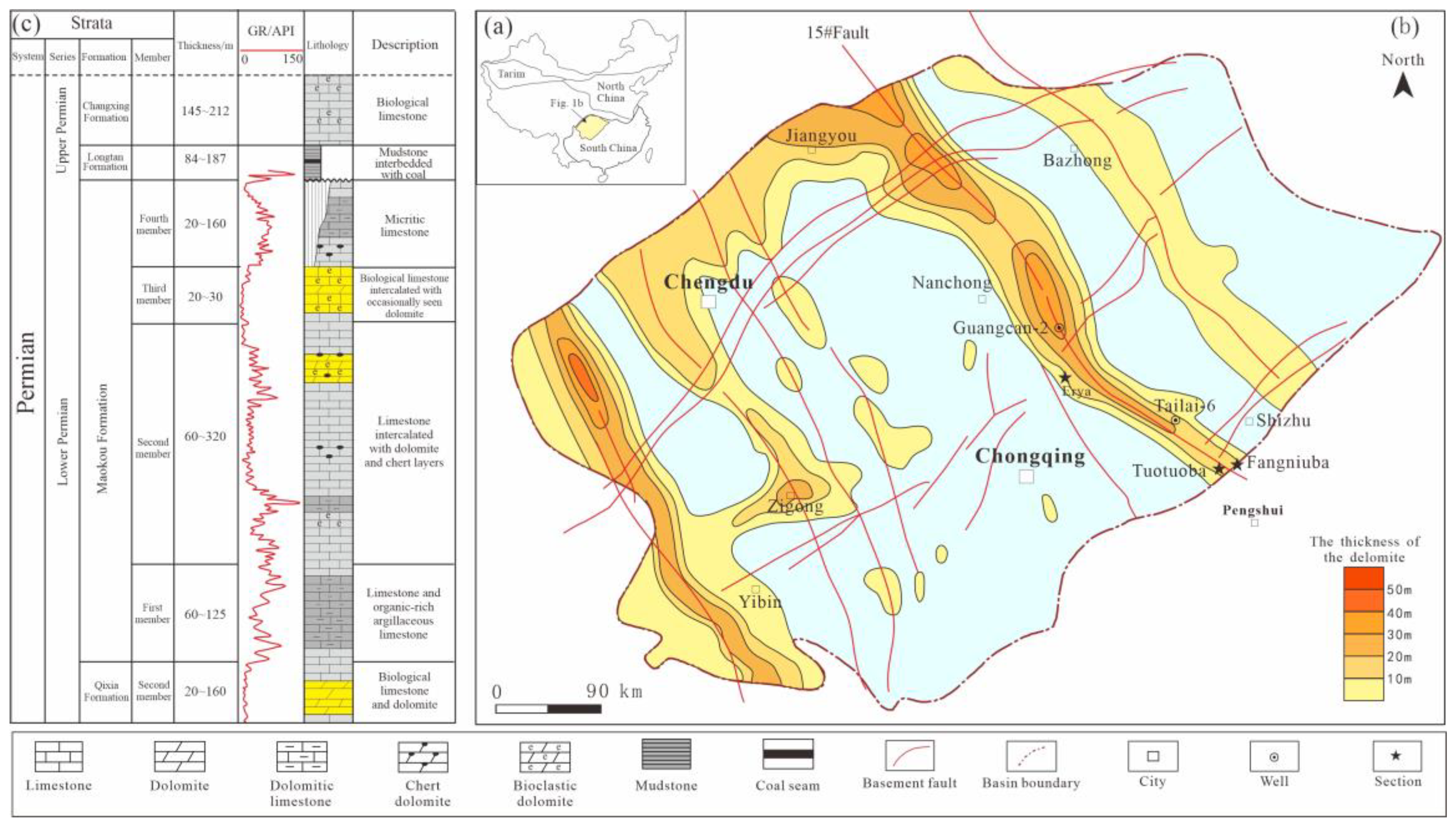

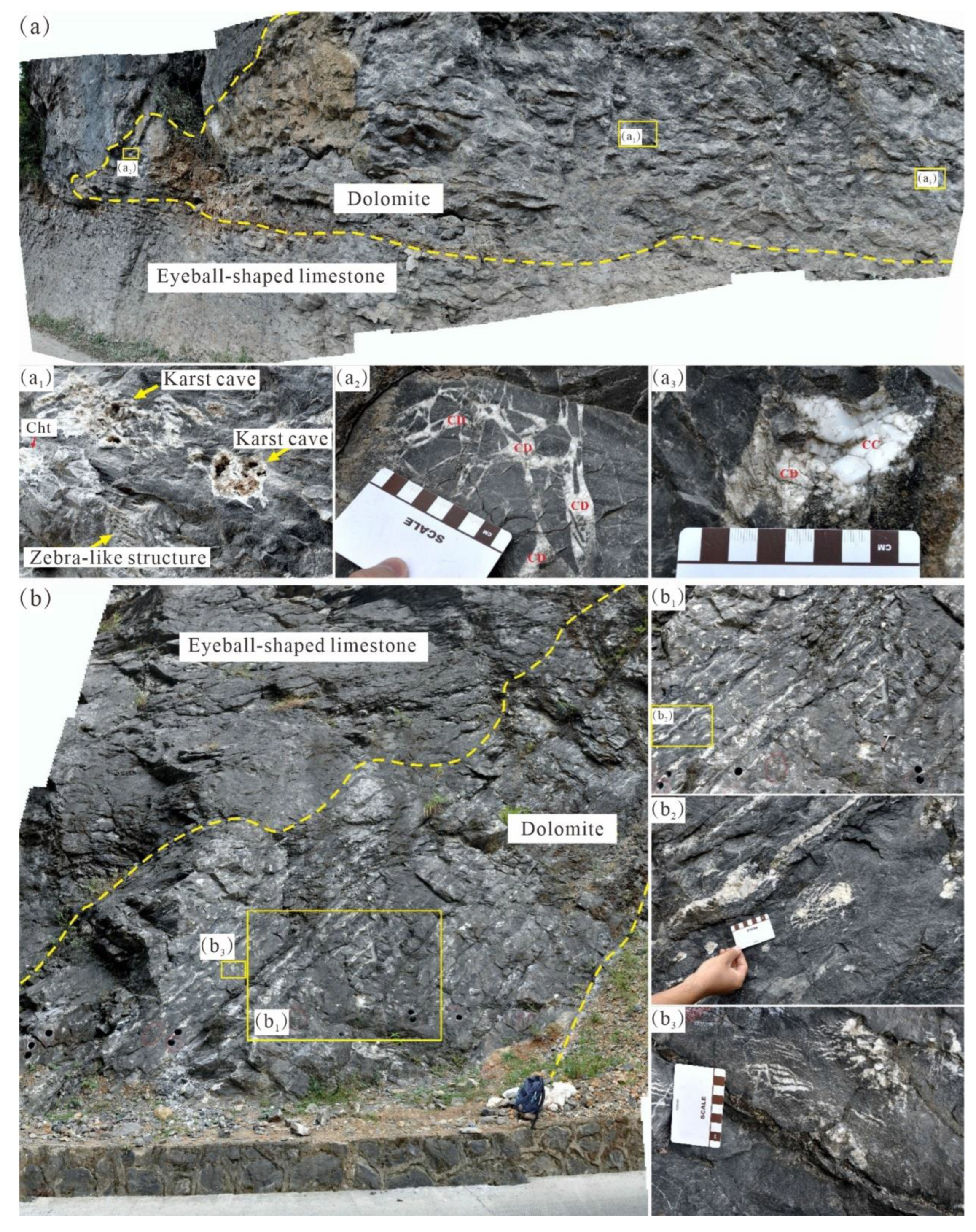
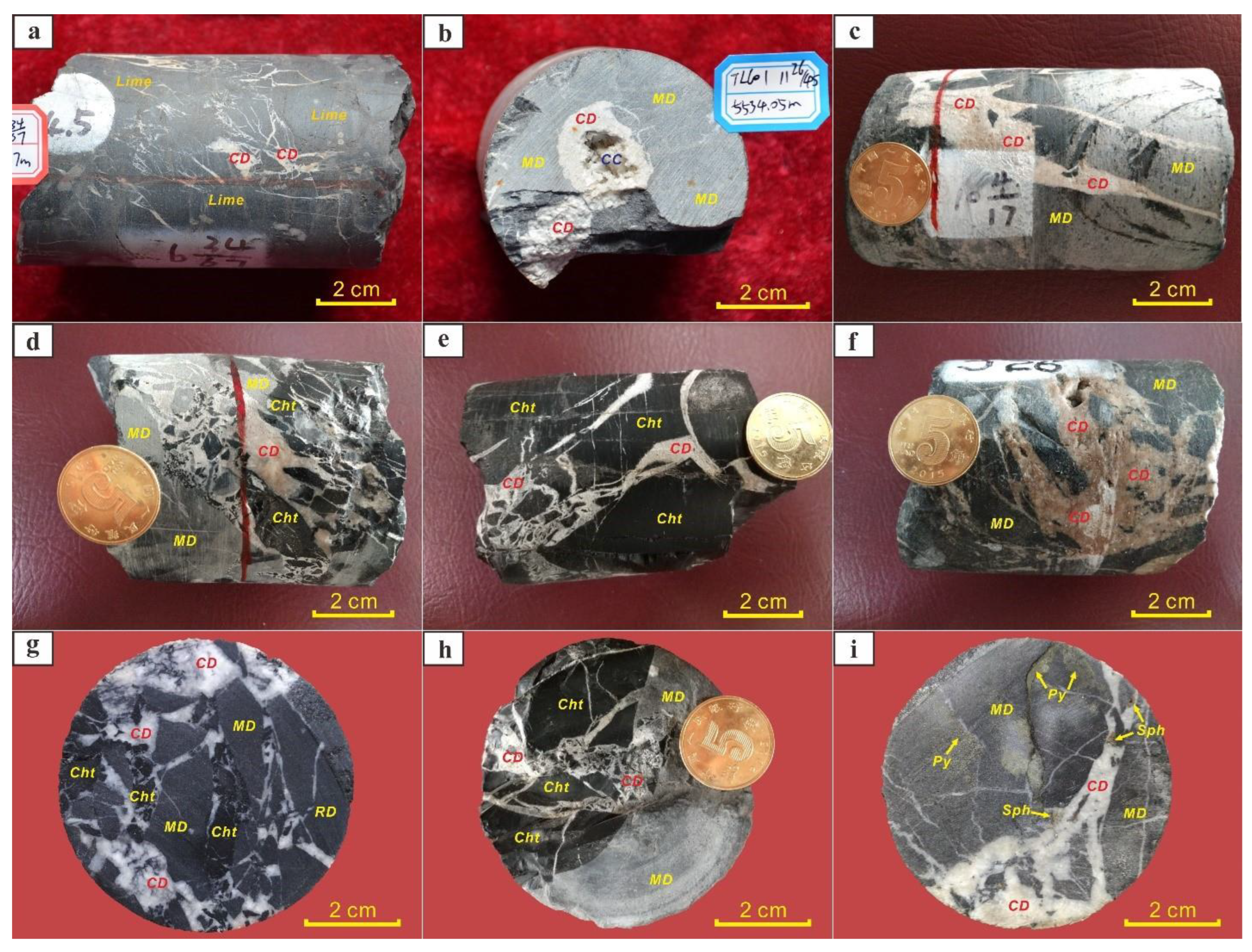
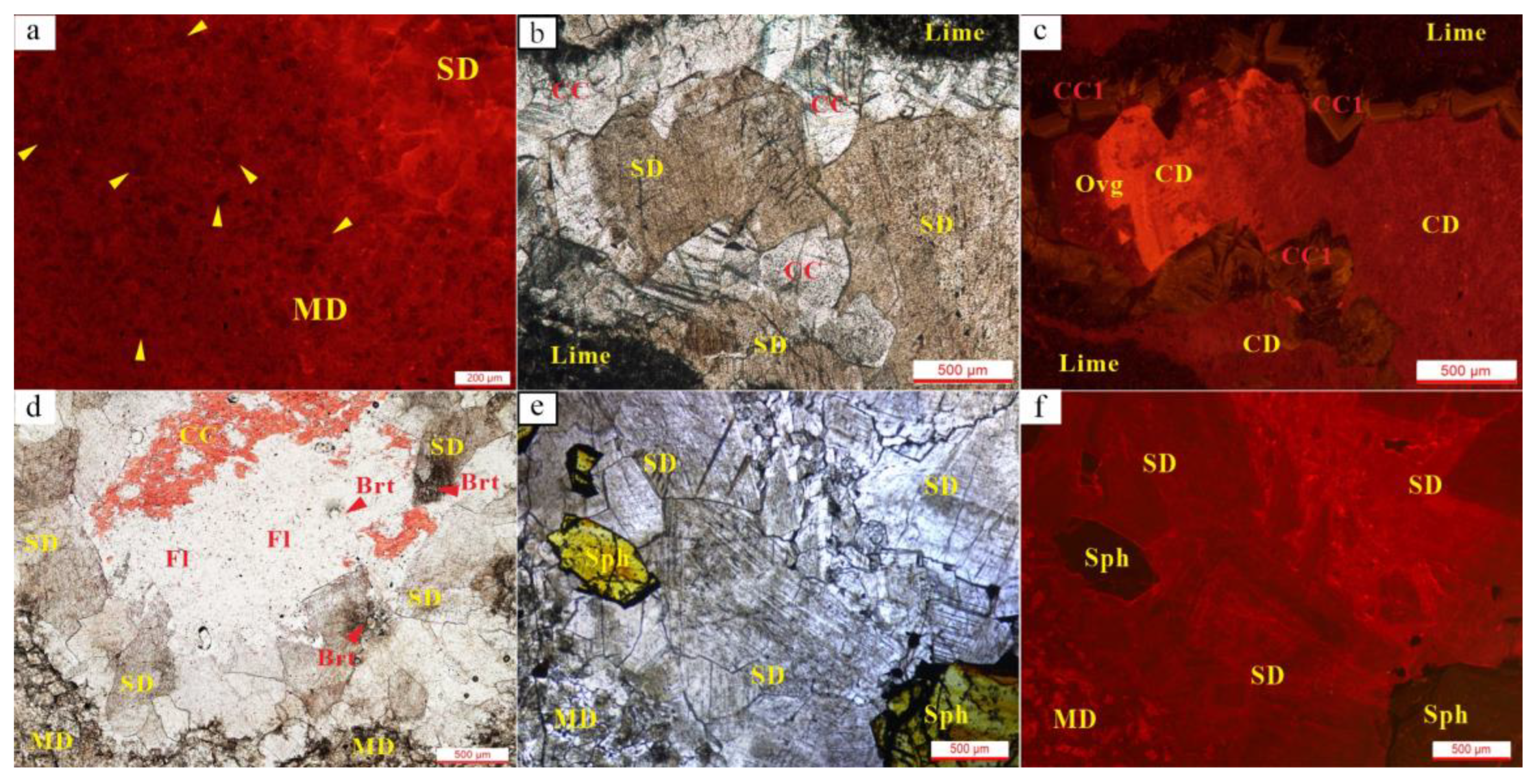
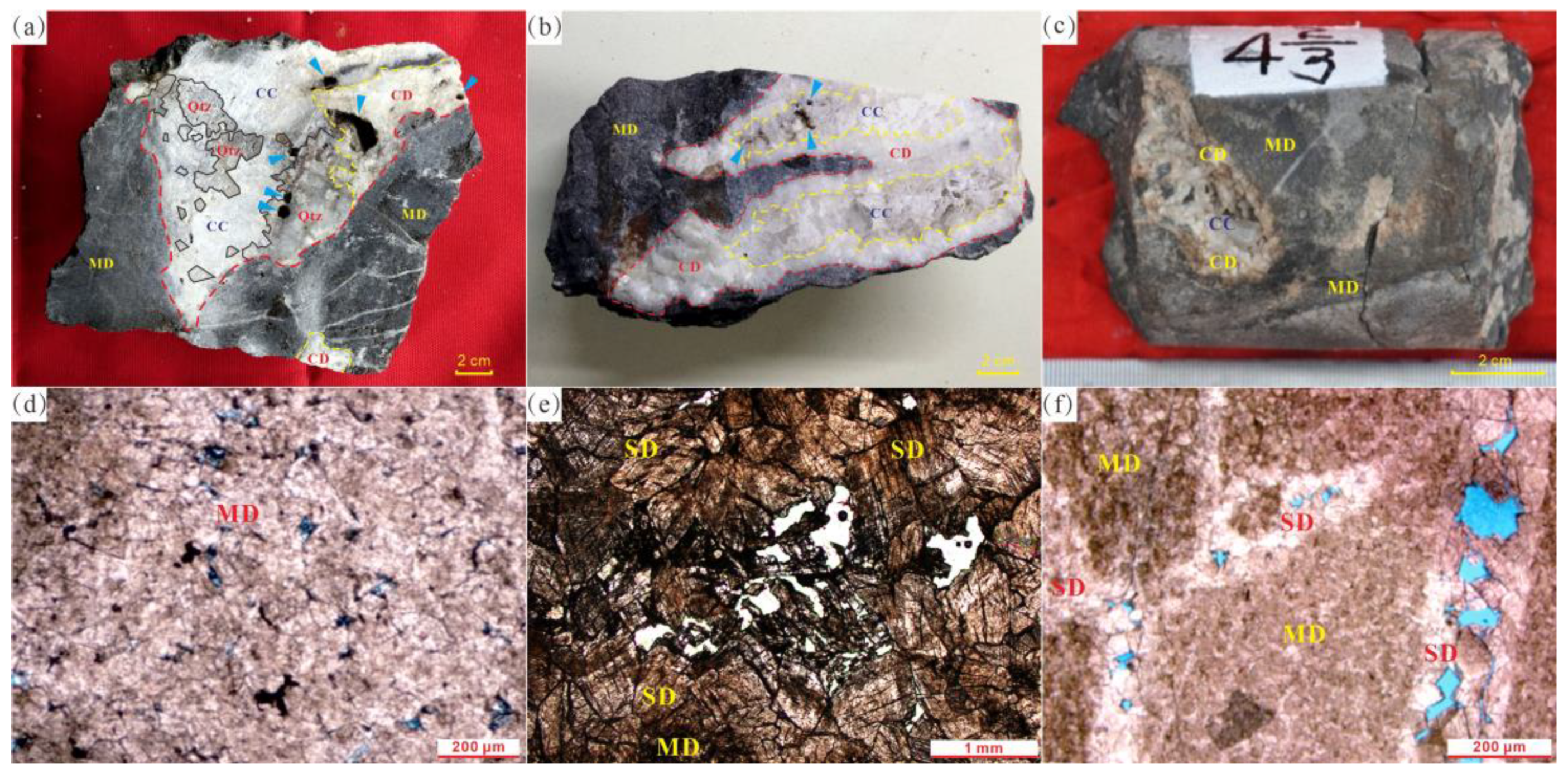
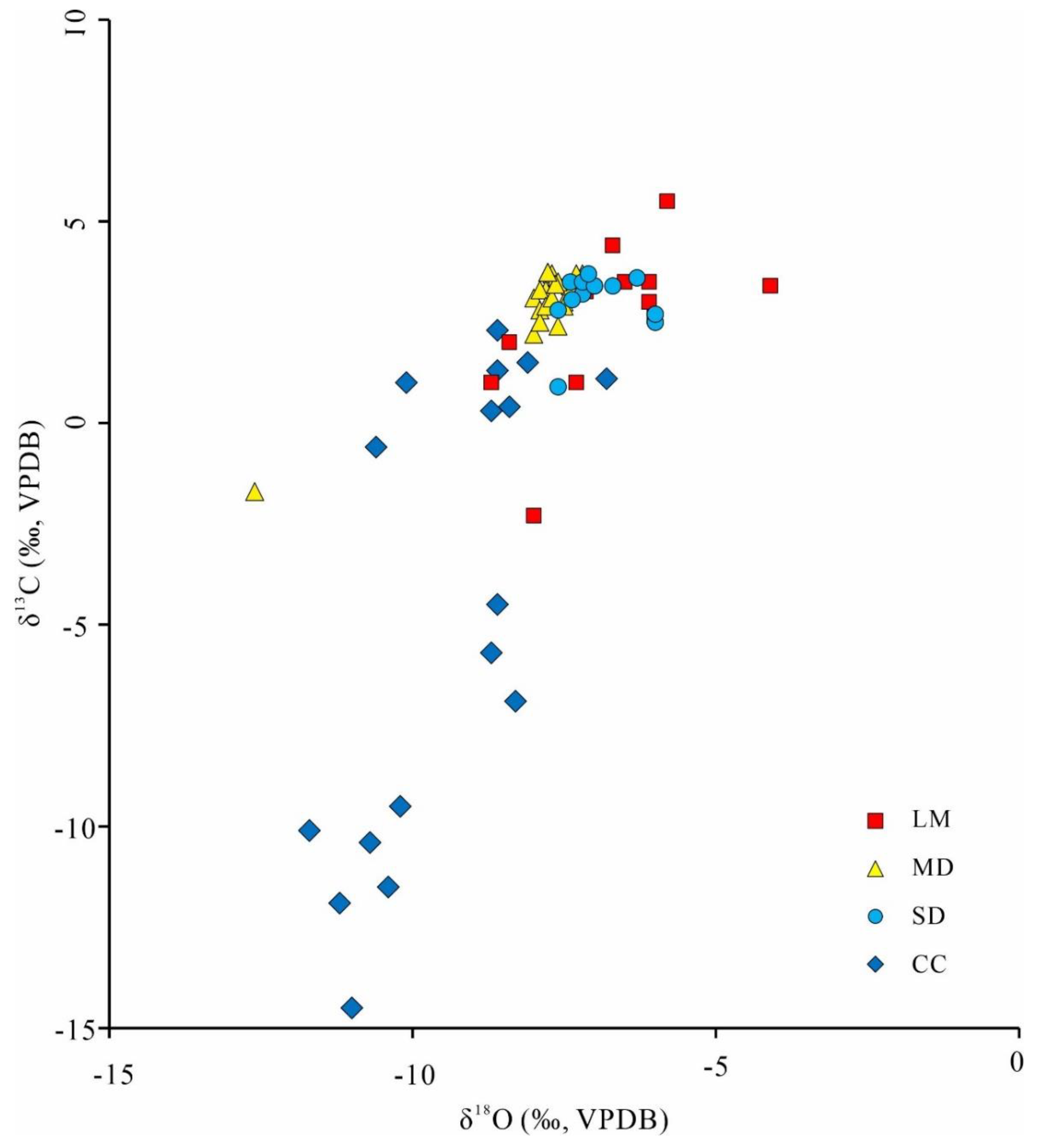
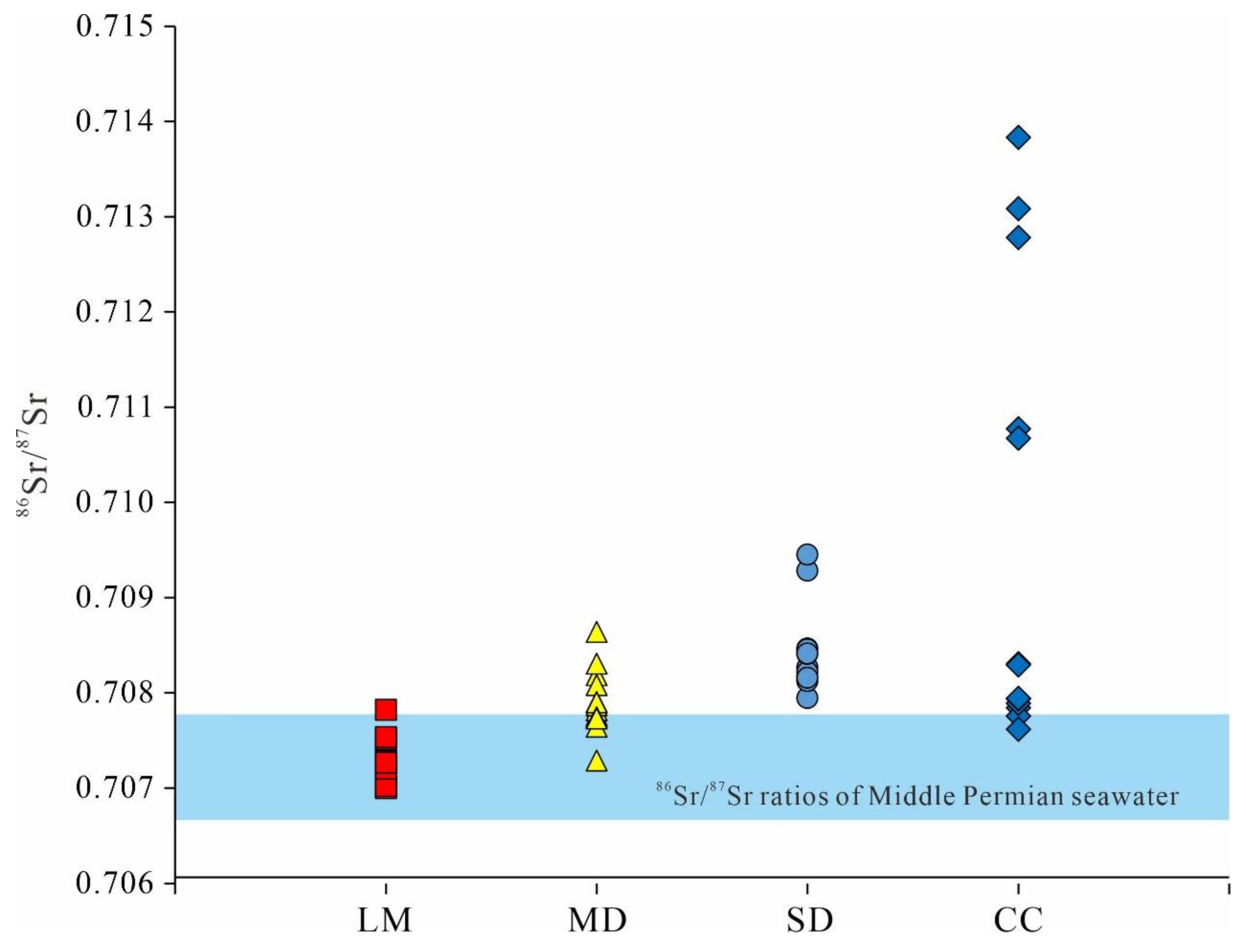
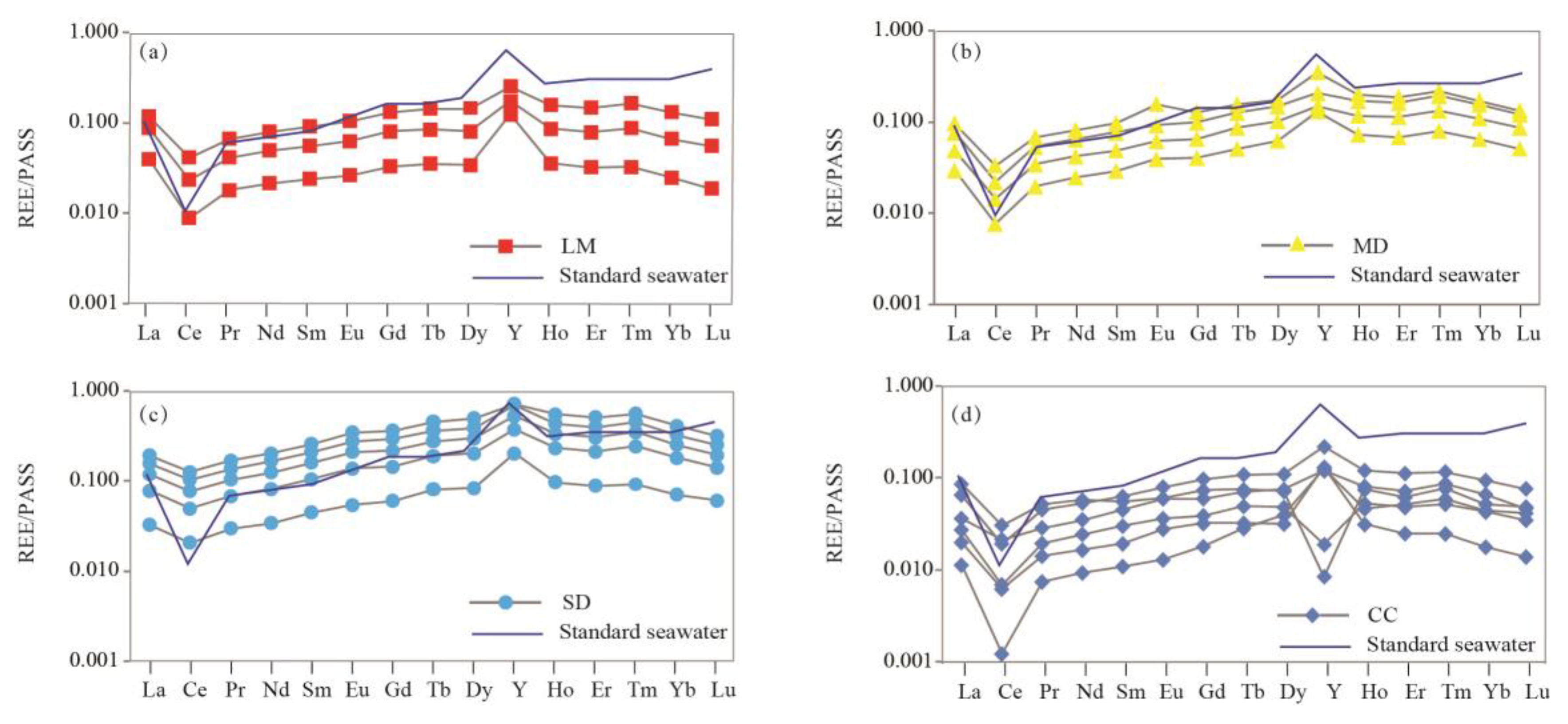

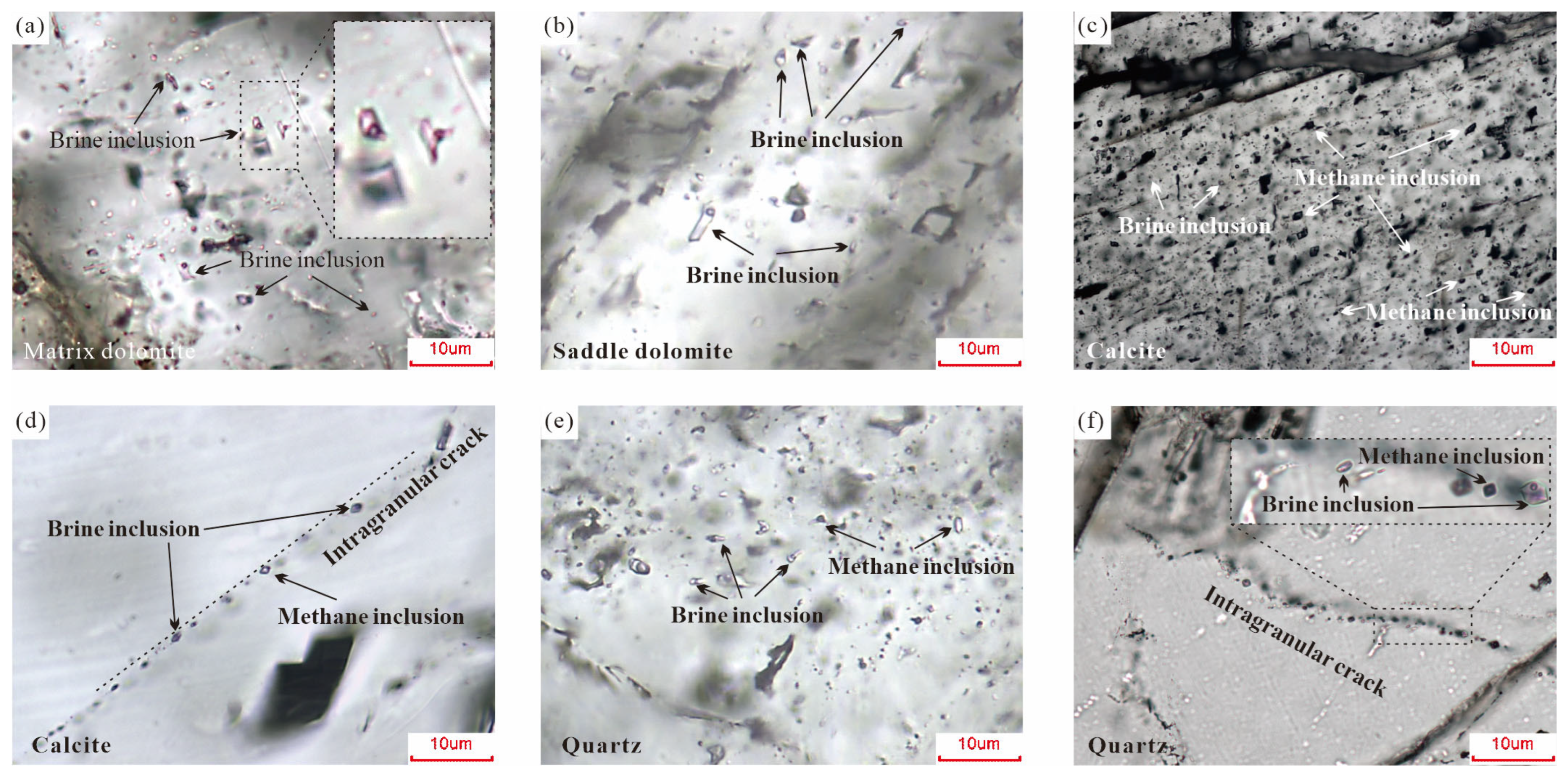

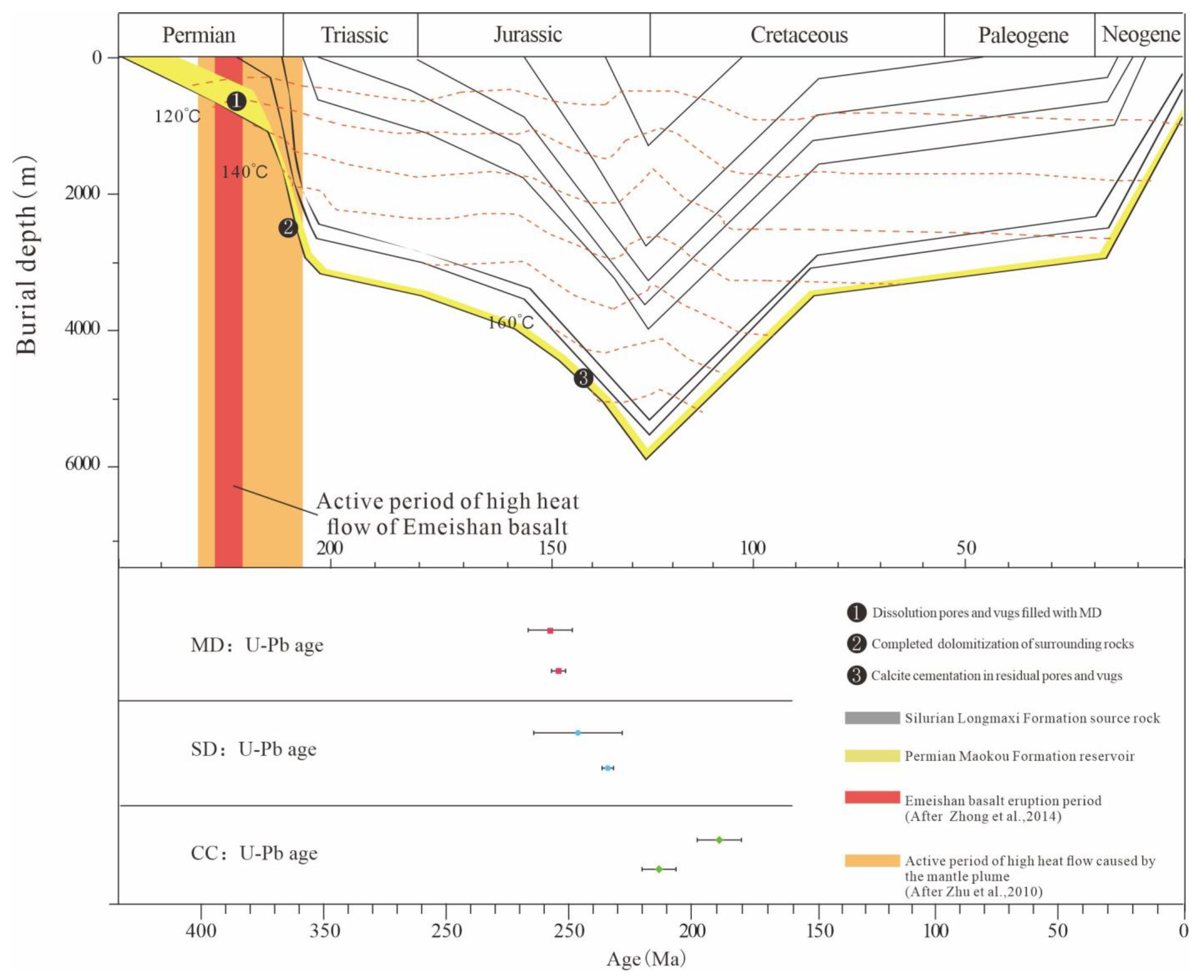

| Rock Fabric | δ13C (‰, VPDB) | δ18O (‰, VPDB) | 86Sr/87Sr | ||
|---|---|---|---|---|---|
| LM | n | 9 | 9 | n | 10 |
| Max | 5.5 | −4.1 | Max | 0.707822 | |
| Min | −2.3 | −8.7 | Min | 0.706997 | |
| Mean | 2.4 | −6.8 | Mean | 0.707256 | |
| S.D. | 2.3 | 1.5 | S.D. | 0.000253 | |
| MD | n | 20 | 20 | n | 18 |
| Max | 3.7 | −6.8 | Max | 0.708640 | |
| Min | −1.7 | −12.6 | Min | 0.707289 | |
| Mean | 2.8 | −7.9 | Mean | 0.707949 | |
| S.D. | 1.2 | 1.2 | S.D. | 0.000305 | |
| SD | n | 10 | 10 | n | 12 |
| Max | 3.6 | −6.0 | Max | 0.708466 | |
| Min | 0.9 | −7.6 | Min | 0.707947 | |
| Mean | 3.0 | −7.0 | Mean | 0.708263 | |
| S.D. | 0.8 | 0.5 | S.D. | 0.000171 | |
| CC | n | 19 | 19 | n | 15 |
| Max | 2.3 | −6.8 | Max | 0.713836 | |
| Min | −21.2 | −15.8 | Min | 0.707617 | |
| Mean | −5.7 | −9.7 | Mean | 0.709362 | |
| S.D. | 6.6 | 1.9 | S.D. | 0.002165 |
| Sample No. | Rock Fabric | La | Ce | Pr | Nd | Sm | Eu | Gd | Tb | Dy | Y | Ho | Er | Tm | Yb | Lu | REE + Y | Ce/Ce* | Eu/Eu* |
|---|---|---|---|---|---|---|---|---|---|---|---|---|---|---|---|---|---|---|---|
| μg/g | μg/g | μg/g | μg/g | μg/g | μg/g | μg/g | μg/g | μg/g | μg/g | μg/g | μg/g | μg/g | μg/g | μg/g | μg/g | ||||
| FNB-14-Lime | LM | 1.50 | 0.696 | 0.158 | 0.716 | 0.131 | 0.028 | 0.152 | 0.027 | 0.157 | 3.32 | 0.035 | 0.091 | 0.013 | 0.069 | 0.008 | 7.10 | 0.306 | 0.922 |
| FNB-18-Lime | LM | 1.81 | 1.16 | 0.207 | 0.954 | 0.176 | 0.039 | 0.219 | 0.038 | 0.215 | 1.34 | 0.05 | 0.133 | 0.022 | 0.118 | 0.018 | 6.50 | 0.412 | 0.918 |
| TTB-20-3 Lime | LM | 1.09 | 1.39 | 0.212 | 1.01 | 0.193 | 0.045 | 0.232 | 0.046 | 0.302 | 2.13 | 0.068 | 0.190 | 0.031 | 0.181 | 0.021 | 7.14 | 0.665 | 0.985 |
| FNB-12-MD | MD | 1.12 | 0.607 | 0.173 | 0.834 | 0.161 | 0.042 | 0.187 | 0.039 | 0.290 | 3.49 | 0.071 | 0.192 | 0.032 | 0.181 | 0.002 | 7.42 | 0.312 | 1.125 |
| TTB-5-1-MD | MD | 0.719 | 0.526 | 0.127 | 0.572 | 0.108 | 0.024 | 0.115 | 0.027 | 0.183 | 0.495 | 0.044 | 0.127 | 0.021 | 0.124 | 0.019 | 3.23 | 0.398 | 1.007 |
| TTB-15-MD | MD | 1.06 | 0.595 | 0.168 | 0.762 | 0.152 | 0.033 | 0.157 | 0.031 | 0.221 | 1.59 | 0.053 | 0.141 | 0.025 | 0.132 | 0.021 | 5.14 | 0.320 | 1.001 |
| TTB-16-MD | MD | 1.12 | 0.684 | 0.167 | 0.75 | 0.157 | 0.030 | 0.169 | 0.031 | 0.192 | 4.74 | 0.052 | 0.129 | 0.020 | 0.131 | 0.020 | 8.39 | 0.356 | 0.861 |
| TTB-22-SD | SD | 1.24 | 1.63 | 0.259 | 1.15 | 0.247 | 0.058 | 0.279 | 0.062 | 0.387 | 5.43 | 0.095 | 0.25 | 0.037 | 0.198 | 0.023 | 11.35 | 0.663 | 1.029 |
| TTB-24-SD | SD | 1.72 | 2.30 | 0.334 | 1.62 | 0.337 | 0.091 | 0.383 | 0.082 | 0.563 | 4.57 | 0.135 | 0.353 | 0.060 | 0.309 | 0.020 | 12.88 | 0.697 | 1.179 |
| TTB-25-SD | SD | 1.76 | 2.51 | 0.359 | 1.66 | 0.355 | 0.077 | 0.420 | 0.086 | 0.585 | 2.43 | 0.138 | 0.364 | 0.059 | 0.271 | 0.015 | 11.09 | 0.727 | 0.925 |
| TTB-27-SD | SD | 1.44 | 2.06 | 0.298 | 1.44 | 0.268 | 0.066 | 0.342 | 0.066 | 0.425 | 4.63 | 0.100 | 0.263 | 0.042 | 0.203 | 0.015 | 11.66 | 0.724 | 1.004 |
| TTB-28-SD | SD | 1.33 | 1.75 | 0.270 | 1.21 | 0.275 | 0.080 | 0.328 | 0.069 | 0.477 | 0.433 | 0.110 | 0.302 | 0.044 | 0.238 | 0.014 | 6.93 | 0.672 | 1.235 |
| FNB-12-Cal | CC | 1.04 | 0.547 | 0.171 | 0.824 | 0.166 | 0.039 | 0.181 | 0.038 | 0.224 | 0.508 | 0.052 | 0.136 | 0.021 | 0.12 | 0.015 | 4.08 | 0.295 | 1.050 |
| FNB-16-Cal | CC | 2.49 | 1.53 | 0.399 | 1.81 | 0.348 | 0.086 | 0.452 | 0.084 | 0.512 | 5.88 | 0.119 | 0.318 | 0.047 | 0.264 | 0.046 | 14.39 | 0.348 | 0.997 |
| FNB-20-Cal | CC | 0.763 | 0.494 | 0.125 | 0.558 | 0.107 | 0.030 | 0.149 | 0.025 | 0.148 | 3.54 | 0.031 | 0.071 | 0.010 | 0.050 | 0.033 | 6.13 | 0.364 | 1.084 |
| TTB-6-2-Cal | CC | 0.434 | 0.098 | 0.066 | 0.317 | 0.061 | 0.014 | 0.084 | 0.022 | 0.184 | 3.40 | 0.046 | 0.149 | 0.024 | 0.126 | 0.006 | 5.03 | 0.131 | 0.893 |
| TTB-8-Cal | CC | 3.29 | 2.44 | 0.459 | 1.96 | 0.31 | 0.065 | 0.343 | 0.058 | 0.335 | 0.227 | 0.074 | 0.175 | 0.031 | 0.147 | 0.020 | 9.93 | 0.444 | 0.930 |
| TTB-21-Cal | CC | 1.38 | 1.71 | 0.253 | 1.19 | 0.249 | 0.064 | 0.277 | 0.054 | 0.349 | 3.22 | 0.080 | 0.203 | 0.035 | 0.186 | 0.018 | 9.27 | 0.663 | 1.136 |
Disclaimer/Publisher’s Note: The statements, opinions and data contained in all publications are solely those of the individual author(s) and contributor(s) and not of MDPI and/or the editor(s). MDPI and/or the editor(s) disclaim responsibility for any injury to people or property resulting from any ideas, methods, instructions or products referred to in the content. |
© 2024 by the authors. Licensee MDPI, Basel, Switzerland. This article is an open access article distributed under the terms and conditions of the Creative Commons Attribution (CC BY) license (https://creativecommons.org/licenses/by/4.0/).
Share and Cite
Li, S.; Gao, J.; Yang, T.; Li, T.; Liu, T.; Hao, Y.; He, Z.; Liu, E. Source and U-Pb Chronology of Diagenetic Fluids in the Permian Maokou Formation Dolomite Reservoir, Eastern Sichuan Basin, China. Minerals 2024, 14, 803. https://doi.org/10.3390/min14080803
Li S, Gao J, Yang T, Li T, Liu T, Hao Y, He Z, Liu E. Source and U-Pb Chronology of Diagenetic Fluids in the Permian Maokou Formation Dolomite Reservoir, Eastern Sichuan Basin, China. Minerals. 2024; 14(8):803. https://doi.org/10.3390/min14080803
Chicago/Turabian StyleLi, Shuangjian, Jian Gao, Tianbo Yang, Tianyi Li, Tianjia Liu, Yunqing Hao, Zhiliang He, and Entao Liu. 2024. "Source and U-Pb Chronology of Diagenetic Fluids in the Permian Maokou Formation Dolomite Reservoir, Eastern Sichuan Basin, China" Minerals 14, no. 8: 803. https://doi.org/10.3390/min14080803






